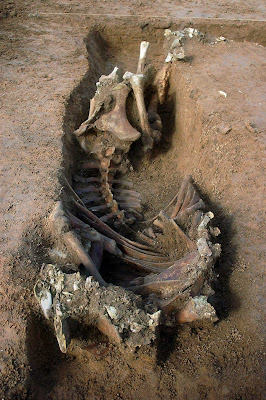 |
| An aerial view of the site [Credit: Canterbury Archaeological Trust] |
Dr John Hammond, a specialist in prehistory at Canterbury Archeological Trust, which carried out the work, said: “This is an incredibly important site. It’s the second confirmed henge monument to be found in Kent [the first was in Ringlemere near Sandwich] and dates back to the period of Stone Henge. It’s incredibly exciting and we look forward to finding out more about how our ancestors lived 5,000 years ago. At the moment it’s a site of regional importance, but in two years’ time we could be talking about one of national importance.”
The trust began investigating the site - part of Meads housing estate - last November.
It was organised ahead of a proposed housing development by Abbey New Homes and followed a dig in 2008 at a neighbouring site which uncovered an Anglo-Saxon cemetery as well as Neolithic, Bronze Age burials.
 |
| A horse's skeleton was among the finds [Credit: Canterbury Archaeological Trust] |
A group of four Anglo-Saxon graves were also discovered. These were thought to be “outliers” from the cemetery found during the 2008 dig. The graves contained a few personal items but the bodies they were buried with did not survive.
Dr Hammond, who also teaches archaeology at the University of Kent, said: “As our research continues, we hope to be able to build up a good picture of life in the Murston and Iwade areas during the early Bronze Age, which at this time is something we only have a very limited understanding about.
“To find a monument of this kind is very rare.”
For more information, visit the Canterbury Archaeological Trust's website

No comments:
Post a Comment